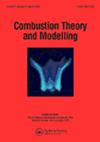利用线性涡流模型的超网格方法进行LES燃烧闭合
IF 1.6
4区 工程技术
Q4 ENERGY & FUELS
引用次数: 0
摘要
LES - LEM是一种湍流燃烧模拟方法,在大涡模拟(LES)中使用随机线性涡模型(LEM)进行亚网格混合和燃烧闭合。LEM可以沿一维线解析所有空间和时间尺度,提供实时的局部湍流火焰统计数据,捕获有限速率化学效应,并直接结合湍流-化学相互作用。然而,这种方法的计算成本很高,因为它需要在每个LES单元中推进一个lem线。为了解决这一问题,本文提出了一种新的紊流燃烧闭合模型。它涉及对LES网格进行粗粒度处理,以生成由细胞簇组成的粗级“超级网格”。然后,每个细胞簇,而不是每个LES细胞,都包含一个LEM域。该领域推进了对流-反应-扩散联合解决方案,并为热化学标量(如物种质量分数)提供了适当的条件统计。然后通过分类条件平均标量的概率-密度-函数(PDF)加权积分获得局部LES过滤的热化学状态,类似于反应性LES的标准假定PDF方法,但对特定条件变量值的完整热化学状态进行基于物理的确定。提出的方法被称为“超级网格LEM”或“SG-LEM”。本文描述了LEM反应扩散的进展,湍流平流的LEM表示,为超网格方法制定的一种新的拼接算法(LES - LEM的关键特征),壁面处理和热化学LES闭合程序。为了验证所提出的模型,使用OpenFOAM库开发了一个基于压力的求解器,并在向后台阶上稳定的预混乙烯火焰上进行了测试,该设置提供了一些DNS数据。SG-LEM提供高分辨率火焰结构,温度和质量分数适合LES热化学封闭。此外,它还提供粗略级别的反应速率数据,这是与其他映射类型闭包方法相比的一个独特功能。将所提出的模型与时间平均DNS数据进行了定量比较,重点是速度、温度和物种质量分数。结果表明,该阶跃下游具有良好的一致性。此外,通过与等效部分搅拌反应器(PaSR)模拟的比较,验证了SG-LEM的优越预测能力。此外,本文简要地考察了模型对粗粒度参数的敏感性,最后探讨了计算效率,强调了与标准LES-LEM方法相比所实现的实质性加速,相对于主要利益强烈湍流状态的PaSR关闭可能有显着的加速。本文章由计算机程序翻译,如有差异,请以英文原文为准。
A super-grid approach for LES combustion closure using the Linear Eddy Model
LES–LEM is a simulation approach for turbulent combustion in which the stochastic Linear Eddy Model (LEM) is used for sub-grid mixing and combustion closure in Large-Eddy Simulation (LES). LEM resolves, along a one-dimensional line, all spatial and temporal scales, provides on-the-fly local turbulent flame statistics, captures finite rate chemistry effects and directly incorporates turbulence-chemistry interaction. However, the approach is computationally expensive as it requires advancing an LEM-line in each LES cell. This paper introduces a novel turbulent combustion closure model for LES using LEM to address this issue. It involves coarse-graining the LES mesh to generate a coarse- level ‘super-grid’ comprised of cell-clusters. Each cell-cluster, instead of each LES cell, then contains a single LEM domain. This domain advances the combined advection–reaction–diffusion solution and also provides suitably conditioned statistics for thermochemical scalars such as species mass fractions. Local LES-filtered thermochemical states are then obtained by probability-density-function (PDF) weighted integration of binned conditionally averaged scalars, akin to standard presumed PDF approaches for reactive LES but with physics-based determination of the full thermochemical state for particular values of the conditioning variables. The proposed method is termed ‘super-grid LEM’ or ‘SG-LEM’. The paper describes LEM reaction–diffusion advancement, the LEM representation of turbulent advection, a novel splicing algorithm (a key feature of LES–LEM) formulated for the super-grid approach, a wall treatment, and a thermochemical LES closure procedure. To validate the proposed model, a pressure-based solver was developed using the OpenFOAM library and tested on a premixed ethylene flame stabilised over a backward facing step, a setup for which some DNS data is available. SG-LEM provides high resolution flame structures, temperature and mass fractions suitable for LES thermochemical closure. Additionally, it provides reaction-rate data at the coarse level, a unique feature compared to other mapping-type closure methods. Quantitative comparisons are made between the proposed model and time-averaged DNS data, focussing on velocity, temperature and species mass fraction. Results show good agreement downstream of the step. Furthermore, comparison with an equivalent Partially-Stirred Reactor (PaSR) simulation demonstrates the superior predictive capability of SG-LEM. Additionally, the paper briefly examines the sensitivity of the model to coarse-graining parameters and finally, explores computational efficiency highlighting the substantial speedup achieved when compared to the standard LES–LEM approach with potentially significant speedup relative to PaSR closure for the intensely turbulent regimes of principal interest.
求助全文
通过发布文献求助,成功后即可免费获取论文全文。
去求助
来源期刊

Combustion Theory and Modelling
工程技术-工程:化工
CiteScore
3.00
自引率
7.70%
发文量
38
审稿时长
6 months
期刊介绍:
Combustion Theory and Modelling is a leading international journal devoted to the application of mathematical modelling, numerical simulation and experimental techniques to the study of combustion. Articles can cover a wide range of topics, such as: premixed laminar flames, laminar diffusion flames, turbulent combustion, fires, chemical kinetics, pollutant formation, microgravity, materials synthesis, chemical vapour deposition, catalysis, droplet and spray combustion, detonation dynamics, thermal explosions, ignition, energetic materials and propellants, burners and engine combustion. A diverse spectrum of mathematical methods may also be used, including large scale numerical simulation, hybrid computational schemes, front tracking, adaptive mesh refinement, optimized parallel computation, asymptotic methods and singular perturbation techniques, bifurcation theory, optimization methods, dynamical systems theory, cellular automata and discrete methods and probabilistic and statistical methods. Experimental studies that employ intrusive or nonintrusive diagnostics and are published in the Journal should be closely related to theoretical issues, by highlighting fundamental theoretical questions or by providing a sound basis for comparison with theory.
 求助内容:
求助内容: 应助结果提醒方式:
应助结果提醒方式:


